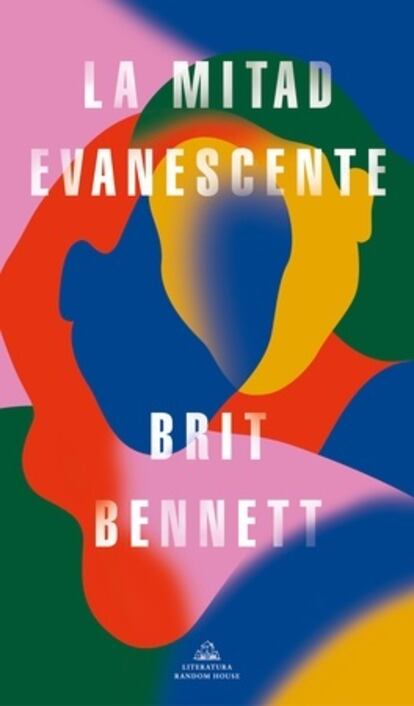In March, Brit Bennett made the cover of Time magazine in its selection of the most influential people of the year.
A strange town:
The twins protagonists of
The Vanishing Half
(Penguin Random House) by Brit Bennett were born in Mallard: "A town that, like any other, was more of an idea than a place." The idea was conceived by Alphonse Decuir in 1848, while he was in the sugar cane fields that he had inherited from his father, who was his master in his day. With the father now deceased, the son - now freed - wanted to build on those hectares of land something that would last forever and ever: a town for men like him who would never be accepted as white, but refused to be treated as black. . A third place. His mother, may she rest in peace, hated her son's fair skin; When he was a child, he would push him into the sun begging it to go dark. Perhaps that was what led him to dream of the people for the first time: the clarity of the skin, like anything inherited at great cost,it was a lonely gift. He had married a mulatto woman with even lighter skin than his own. She was then pregnant with her first child and he imagined the children of her children's children even lighter skinned, like a cup of coffee gradually diluted with milk: a more perfect black. Each generation of skin lighter than the last.
Soon the idea and the place became inseparable, and Mallard spread.
People of color murmured about it.
They wondered what was going on there.
The whites couldn't even believe it existed ”.
“When Santa Catalina was built in 1938, the diocese sent a young priest from Dublin who, upon arrival, thought he was lost. Hadn't the bishop said that Mallard's neighbors were people of color?
In that case, who were those people who went from here to there?
Light-skinned, blonde and red-haired, the darkest no more tanned than a Greek?
Was that what people of color were considered to be in America?
The people the whites wanted to segregate?
In that case, how did they distinguish between them? "
If the founder of the place - son of master and slave - Alphonse Decuir had been able to walk through the town that he once imagined, “he would have been thrilled to see his twin great-great-granddaughters, snow-colored skin, brown eyes and wavy hair.
He would have been amazed that the son was a little more perfect than the parents. What could be more extraordinary? ”Asks Bennett.
Cover of the Spanish version of The evanescent half.
A city to find work:
“As soon as they got to New Orleans, they found a job in the draining room at the Dixie Laundry, where they folded sheets and pillowcases for two dollars a day.
At first, the smell of clean clothes reminded Desiree so much of home that she almost cried.
The rest of the city was filthy: urine-spattered cobblestones, overflowing garbage cans in the streets.
Even the drinking water had a metallic taste: it was from the Mississippi River, said Mae, her shift supervisor.
Who knows what they will throw at him ”.
A residential neighborhood in Los Angeles:
Observing the white population, one of the protagonists discovers the freedom to show herself.
“I had catered a party for a real estate agent who had sold houses to Burt Reynolds and Raquel Welch.
He had wandered through the house, admiring the long white sofas, the marble countertops, and the huge windows that melted into the view of the beach.
She had no idea what it was like to live in a place like this: suspended from a cliff, exposed to everyone's sight through glass.
But maybe the rich didn't feel the need to hide.
Perhaps wealth was the freedom to show oneself "
After that discovery, imagine the continuation of that story.
"In the next century the rich would leave the cities, they would lock themselves behind gigantic gates like medieval lords behind their moats."
Interracial coexistence.
The blacks:
"His house spoke another language, that of palatial decoration:" the floor of the living room adorned with a white fur rug, a floor lamp with a gold shade, the vase covered with a mosaic of tiles on the mantelpiece. "
A simple house was a hallmark of good taste.
“Only the lower class lived like this, with gold-covered furniture, junk everywhere.
On the long leather sofa, three colored women were drinking wine and listening to Aretha Franklin "
The whites:
“Dale Johansen asked what the hell was the use of having a homeowners association if it wasn't to stop things like that from happening [the arrival of a black family]. Tom Pearson, determined to overcome Dale's bravado with his own, threatened to stop paying his dues if the association did not begin to do its job. Even the women were upset, or perhaps they were the most upset. They weren't yelling like the men, but each had made some sacrifice by marrying a man who could afford a home in the most expensive new development in Los Angeles County and was expecting the benefits of that investment. Cath Johansen asked how they hope to keep the neighborhood safe and Betsy Roberts, an economics student at Bryn Mawr before they got married, lamented that their property values would plummet. "
And the neighborhood show house:
Whose advertisement read: “Imagine your life here.
Imagine who they could become ”.

